In Volleyball there are 3 main formations.
Each of these formations has their own set of rotations, some being much trickier to get to grips with than others.
Table of Contents
The 3 Volleyball Formations are as follows:
4-2 Volleyball Formation
The first number in the formation represents the number of hitters on court at any given time and the second number represents the number of setters.
For example the 4-2 formation has 4 hitters and 2 setters on court any given time.
In this article I am going to cover the following things about the 4-2 formation.
I am going to cover what the 4-2 formation is, what the advantages and disadvantages of this formation are and most importantly exactly how you rotate round the court for both serve receive and serving.
What is the 4-2 Volleyball Formation
As touched on above the 4-2 Volleyball Formation gets its name from how many setters and how many hitters are on the court at any given time.
So in this case the 4 represents the number of hitters and the 2 represents the number of setters.
In this formation as you have two setters there is always one setter in the front row and one setter in the back row at all times.
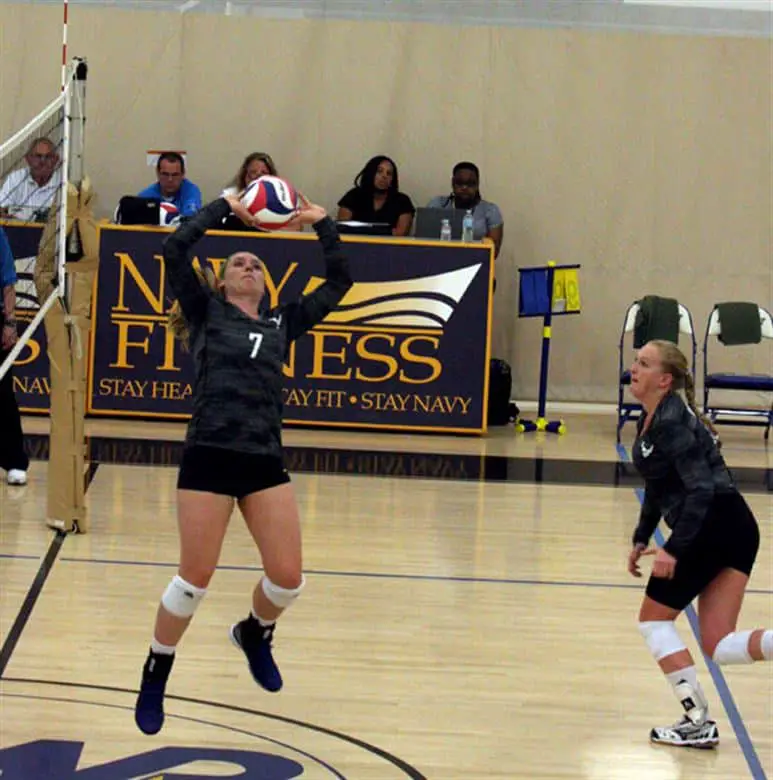
When playing this rotation the setter in the front row will be the designated setter the whole time they are in the front row.
When that setter moves to the backrow the other setter on court will become the primary setter as they move to the front row.
Now this may seem confusing now but hopefully when we get to the diagrams later it will all make sense.
This formation is most commonly used in beginner level or lower level volleyball, the main reason for this is because it takes away a lot of the confusion surrounding rotations and even spur of the moment decisions.
This allows players to really focus on developing their skills and understanding what parts of the game they want to master.
What Are The Advantages of The 4-2 Formation In Volleyball
Very Beginner Friendly
So I mentioned above that this formation often lends itself to beginner levels or lower levels. There are actually a few reasons why this is true.
The first reason is because there are only 3 rotations to learn and on top of that (as you will see later) the rotations are actually really quite easy to pick up and learn.
This rotation also reduces a lot of decision making which again makes this rotation perfect for any new players trying to improve at the game without clogging their brain with advanced strategies.
Great Introduction To Rotations
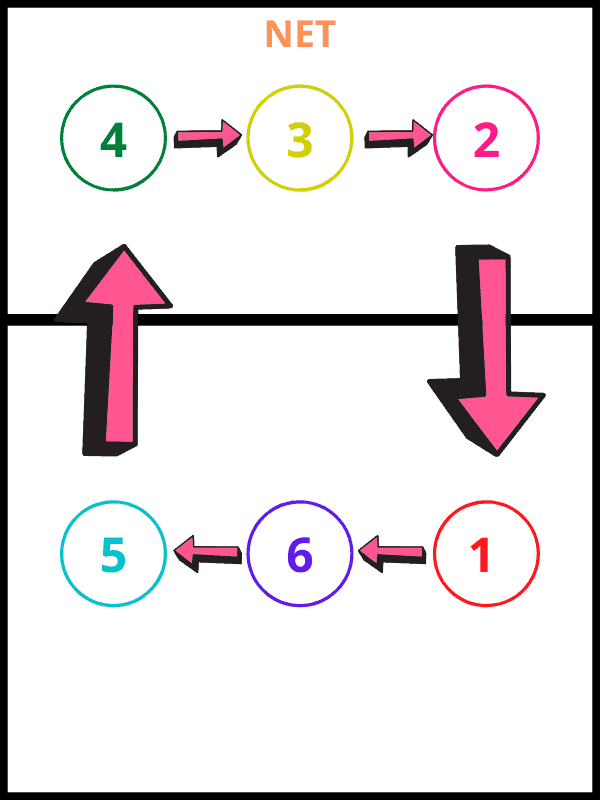
As mentioned above, having just the 3 rotations and them being quite easy to understand and pick up makes this formation a great way to teach players the general gist of rotations without overcomplicating or overloading new players with too much information.
Although these rotations are different to the other formations, I feel when you break down rotations to core principle they are actually quite easy.
We rotate for two reasons, the first reason is because we must line up in certain ways to not break the rotation rules, the second reason is because we want to get each player into their preferred or strongest position as quickly and efficiently as possible.
Learning the 4-2 rotations teaches these core principles which really helps beginners quickly pickup more advanced rotations later down the line.
Easier Decision Making
As the Setter in the front row is always the primary setter it means that there are only two hitters in the front court to choose from.
This means that it reduces the amount of options the setter has which makes it much easier for the setter to determine who they are going to set.
Reducing the options allows the setter to really focus on technique and it also conditions the hitters to be ready at all times for the attack.
Makes Serve Reception Easier
Now this one can be seen as a negative or a positive.
Obviously making serve reception is always a positive however the method itself will work for some players and some teams however it will add confusion to other teams.
In this formation it can be really easy to add extra passers into the serving line with receiving the service.
A normal passing line would consist of 3 passers however with the setter in the front row being the primary setter you can have upto 5 players in the serve receive at any one time.
Now you are probably thinking.
‘Well why would this ever be a bad thing?’
Well for most teams it probably wouldn’t be, however I think it is fair to say if you have played any amount of volleyball you will have seen the situation where two players both move towards the ball but then see the other player and stop completely meaning no one plays the ball.
This is particularly common in serve receive situations, because of this I personally find passing out of a less clustered backline is better.
However I do see the benefit for beginner players as the more players to pass the ball the greater the chance of getting a good pass into the setter.
Full Back Line of Defenders
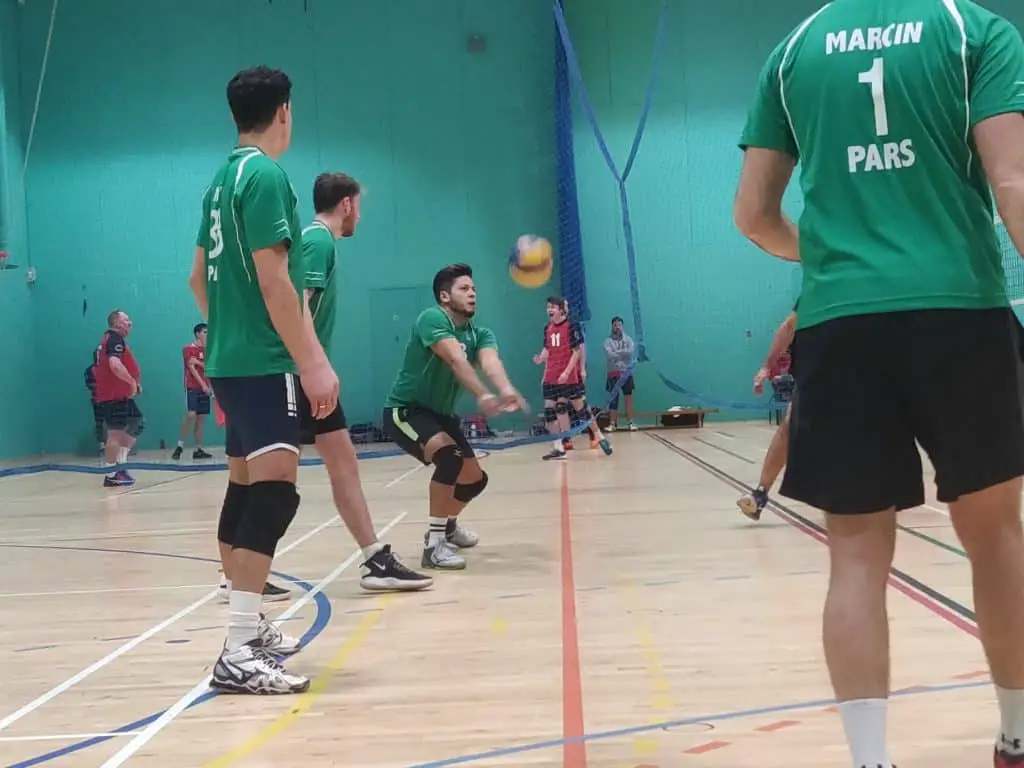
The last main benefit to using the 4-2 formation is the fact that at all times you have 3 set defenders.
Unlike both of the other formations where the setter is one of the back row players for nearly all or at least half of the rotations.
By having 3 dedicated back row players at all times it greatly increases the chances of digging the ball and having a strong consistent defensive line.
This is particularly when it comes to lower levels where backcourt setters are so keen to get in position to give themselves a better chance at a good clean set.
By removing this scenario completely it can massively benefit the defense.
What Are The Disadvantages of The 4-2 Formation In Volleyball
As with all things in life where there are benefits there are drawbacks.
Reduces Setting Consistency
Where the setters are constantly switching this obviously leads to less repetitions for both setters which not only affects how much the setters improve and are consistent but it also massively affects the hitters.
Now you may be thinking.
‘How exactly does it affect the hitters?’
Well each setter has their own style, speed and tendencies when it comes to setting, where the setters are constantly switching it can make learning the hitters preferences difficult and mastering the consistency of setting each player how they like even harder.
Not only that but it can affect the teams tempo.,
For example if one setter likes setting quick and short, the hitting players might not be used to this and therefore be late, alternatively if they do react to the quick sets and then the next setter likes to set high and loopy, the hitters would always go in too quick and find themselves underneath the ball.
Finding a nice rhythm and tempo as a team is extremely important especially in the early stages of a match as it can greatly affect your success rate
Very Predictable
Another downside to this formation is because the setter is always front court and there are only ever 2 front court hitters, it can become very predictable and if the other team is clever enough they can quickly start reading the set and shutting down the attacks.
The only real counter to this is learning to set the back row players as they will provide different hitting angles and options which can keep the opposition guessing as to where they line up the block.
Never Have Three Attackers
Staying on the same track as above the large major downside to this formation is the lack of the third front court hitter.
In both of the other formations there are situations in which there are 3 front court hitters which can be very difficult for the opposition team to read and block.
In this formation because the setter in the front row also becomes the primary setter it means you instantly lose a third hitting option in the front row.
The main counter to this is with the help of over passes or tight passes.
By overpassing or passing tight to the net it can give the setter the option to attack the ball on the 2nd contact or get clever with some trickery and set straight over or dump the ball.
General Practices of The 4-2 Volleyball Rotation
Setter Plays At Position 2 (Front Right)
Now admittedly some teams may run this formation slightly differently however I would suggest when in this formation the setter should also play at position 2 (The front right position).
If the team lines up in this formation it means when passing the ball it should also be played to the right front area of the court.
This is a great way of running this formation as it helps players focus on passing to the right areas for the other formations that they may play later.
Another great reason to have the setter at position 2 is it means the setter only has to worry about setting directly forward and not worrying about trying to reverse the set before they are comfortable with the skill.
Setter In The Back Row Focuses On Defense Only
Now I have already touched on this when I spoke about the advantages of the formation however when playing the 4-2 the setter in the back row becomes a defensive player only.
Now that doesn’t mean they can’t be available to hit the ball when needed however it does mean they can solely focus on defense. Unlike in the 6-2 where the back row setter is constantly trying to creep forward ready to take the set and often leaving the defensive duties to other players.
Back Court Players Need To Be Ready To Attack
When I mentioned the drawbacks to the formation I talked about how the formation can be very predictable for the opposition as there are only two front court players.
As I said earlier due to this it is important that the back court players are ready to attack when needed.
Another reason why it’s important is because this formation is often used at beginner or lower level, it is highly likely that the pass isn’t always going to be perfect.
When the pass is a long way from the net sometimes it can be a tall order for the setter to force the ball back to the front court players, sometimes it is much easier and more efficient to set a back row player.
Serve Receive Rotations for the 4-2 Rotation In Volleyball
For the sake of these rotation guides I am assuming the front court setter is at position 4 (Front Left position) and the other setter is starting serving
To better explain what I mean please see the below line up guide.
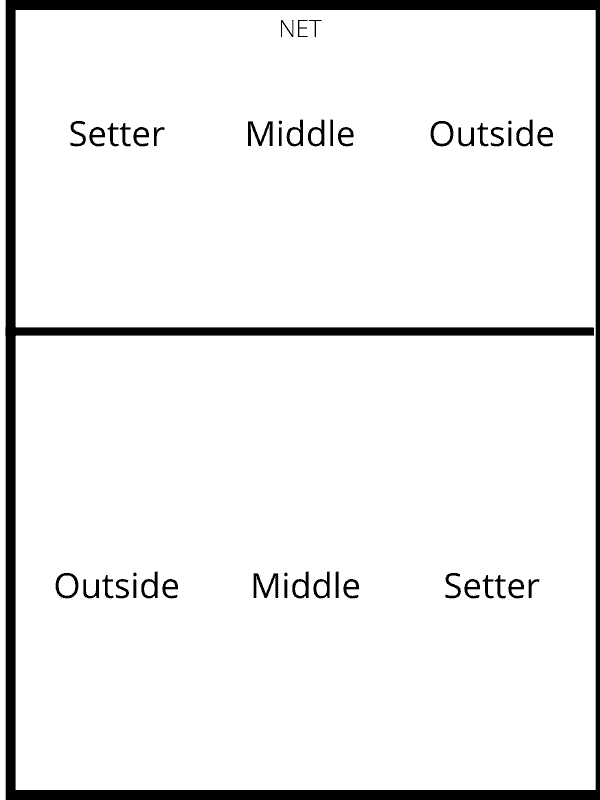
Rotation 1
So when it comes to the first rotation when we are the serving team.
We obviously want to get our setter to the front right position as quickly as we can, however, where possible we want to try and ensure our middle blocker is closest to the net so they can be ready to react to any overpasses or get ready to block the quick attack.
To achieve this we push our middle player in the front row, nice and tight to the net and then stack the setter just to the left of the middle and the outside hitter just to the right of the middle.
This ensures they stay in rotation.
The second that ball is served the setter and outside will switch positions and get ready to block.
Regarding the back row, this actually isn’t as important and honestly each coach sets this up slightly differently.
Personally I like the middle player in the back row to be playing at position 5 (Back Left) and the outside player at position 6 (Middle Back).
But your coach may line you up differently so just bare this in mind.
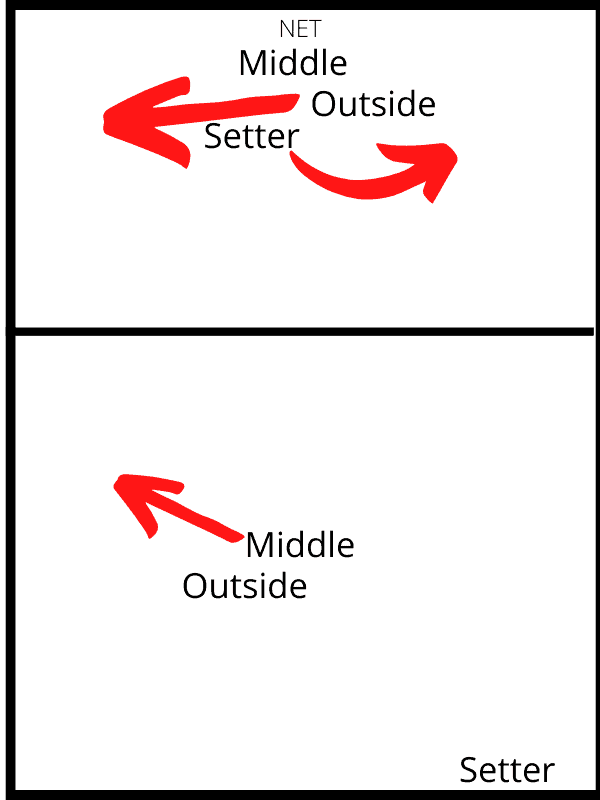
Rotation 2
Moving on to rotation 2 the outside player is already in the right location, so in the front row the only two players that need to switch are the setter the and the middle player.
As mentioned above we ideally want the middle blocker to be close to their position and tight to the net.
To acheive this we bring the middle closer to the middle of the court and have the setter stack just to the left of them.
The second the ball is served the setter will run past the middle to their designated position.
The back court is actually nice and easy.
The setter in the back row who is playing defense would normally be at position 6 (Back Middle) however, as the outside player who would be at position 1 (to the right of the setter) is off the court.
The setter can actually stand in their base position without worrying about the rules of rotation.
In this rotation all back court players can stand in their base positions and the outside will simply step on court after serving.
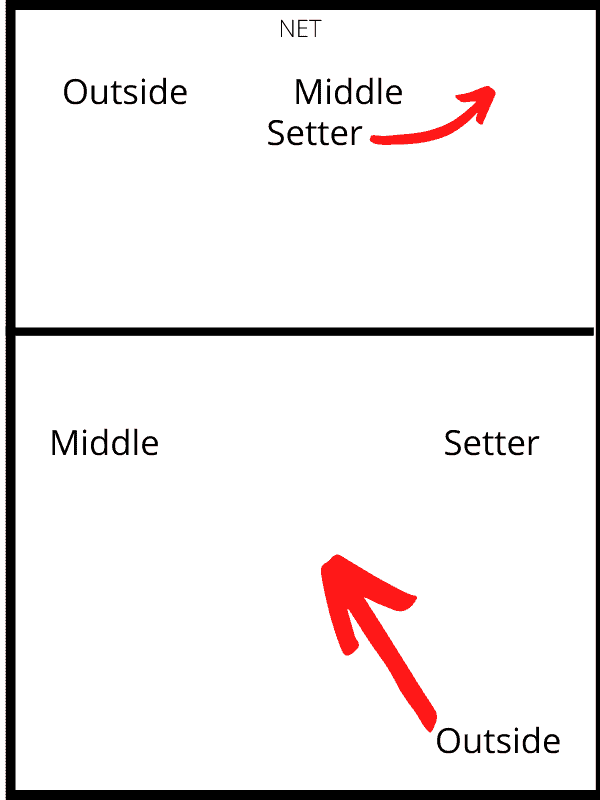
Rotation 3
Moving on to the last rotation, we actually have the opposite of what we had just a second ago. This time the setter is in the correct position and the outisde and middle need to switch.
Again the middle ideally needs to be ready at the net to block or punish and overpass.
Based on this the outside player would stack just to the right of the middle player and run straight past the middle to their desired spot once the ball has been served.
Now you may look at the below and think the back court is a little crazy.
In reality the middle player who wants to run on court after serving to play position 5, could actually just stand on the left side of the court to serve rather than serving from the right and running round everyone.
Again as the person serving is off the court they aren’t affected by any rotation rules.
Once the middle’s awkward journey is out of the picture you are left with a simple transition for the setter who will stand near the outside before running across them and forwards to their base positition at zone 1.
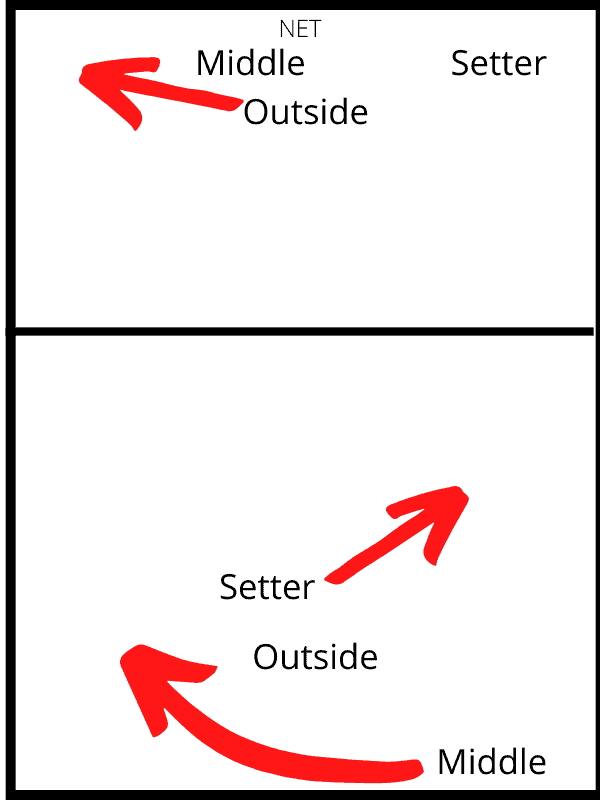
Serve Rotations For The 4-2 Rotations In Volleyball
Unlike the rotations above I am starting with our setter at the front right position, this just means the setter is already in their ideal position so can just focus on setting the ball well.
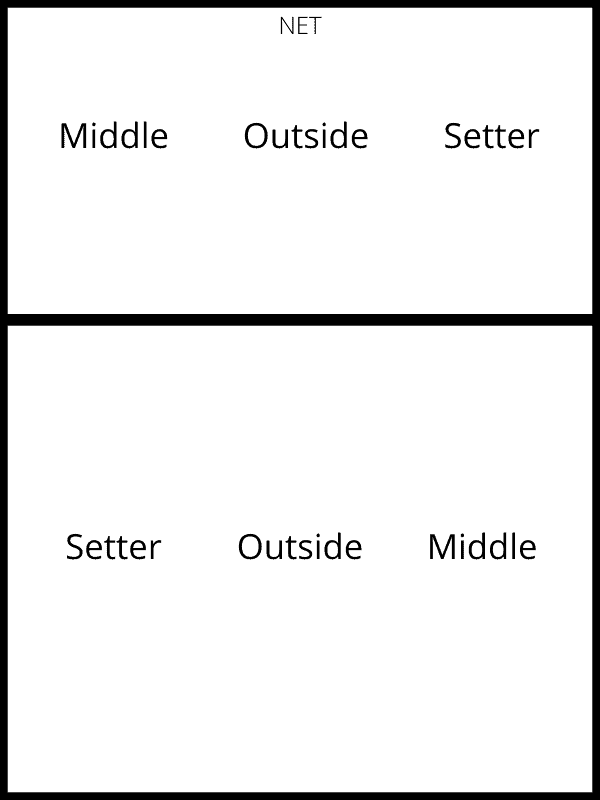
Rotation 1
Now the serve receive rotations are slightly more confusing but I am confident you can get your head round them with the below diagrams.
In rotation 1 we actually have quite a few players not in their preferred positions.
First looking at the front row, the setter is already in the correct spot however we need the middle and outside players to switch positions.
The best way of doing this is by getting both players to stack towards the left of the court.
This allows the passing players to have a clear view of the serve and also allows the outside and middle the shortest distance to their positions.
Looking towards the back row after we have passed the ball we want to switch the middle player and the 2nd setter.
Once the ball has been passed the middle and 2nd setter will simply run across and swap positions.
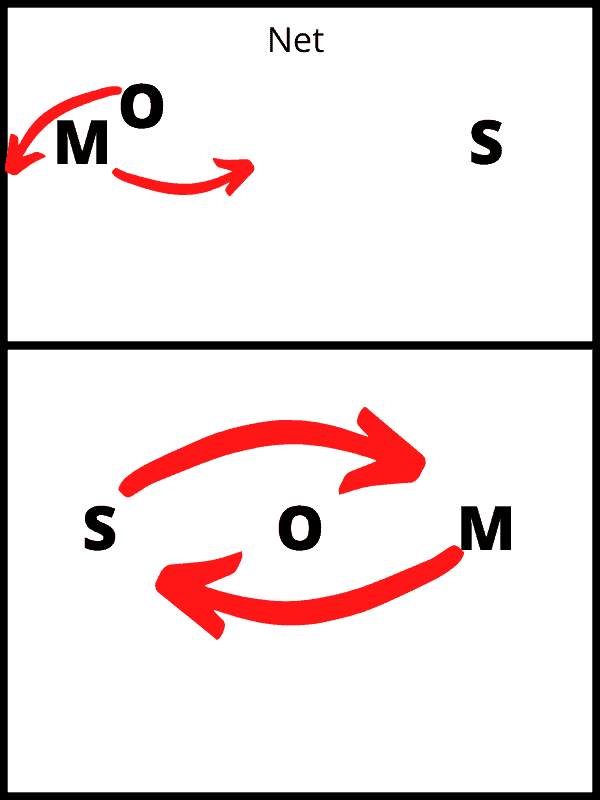
Rotation 2
Moving on to rotation 2 our front line is flipped, so our middle player is in the correct place leaving our setter and outside needing to swap positions.
The most effeceint way of doing this is by stacking all three players in the middle of the court.
The second that ball is served the outside and setter can quickly swap.
The back row is slightly more simple this time as the 2nd setter is already in the correct location.
Once the ball has been passed the middle and outside simply need to swap places and get ready to cover the hitter.
 Rotation 3
Rotation 3
Moving onto the final rotation and arguably the most simple rotation of the 3.
Although the setter and Middle in the front row are the wrong way round they can actually stack towards the right side, this puts the setter in the ideal location whilst still giving the middle a nice running angle and view of the ball the whole time.
The outside in the front row can simply stand in their ready position proividing they leave a clear view for the passers behind.
In the back row we just need to swap the 2nd setter and outside once the ball has been passed up.

Full 4-2 Rotation Walkthrough
Now you may be confused as to why when I have just gone through the serve receive rotations and serve rotations, how I still have more to add.
Well my goal in this article was to ensure when you walk away after reading this you feel 100% confident with this rotation.
So to ensure you fully understand this rotation I am going to go through step by step both rotations as if the game were playing out in front of us.
Let’s work through the rotations assuming we just won the coin toss and choose to serve first.
Serve Rotation 1

It is a close rally but unfortunately you hit out and the other team wins the serve
Serve Receive Rotation 1

A great pass in to the setter allows the setter to put a perfect set out to the wing for the outside to get their first kill of the game
Serve Rotation 2

The server makes a mistake and the serve drops short, the point goes to the opposition
Serve Receive Rotation 2

The opposition serve is good but another good pass in allows the setter to dump the ball winning the point for your side
Serve Rotation 3

It must be contagious, it’s another service fault.
Serve Receive Rotation 3

The opposition go for a float serve but your team is quick to see the trickery in the serve and side out the point.
Now we are back to the start of the rotations so just go back to rotation 1 and repeat the process.
Sorry I got a little bit carried out with the commentary, but hopefully you are now clear on exactly what the 4-2 formation is and exactly how to rotate.
If you want to watch a video version explaining this principle check out my youtube video below.
